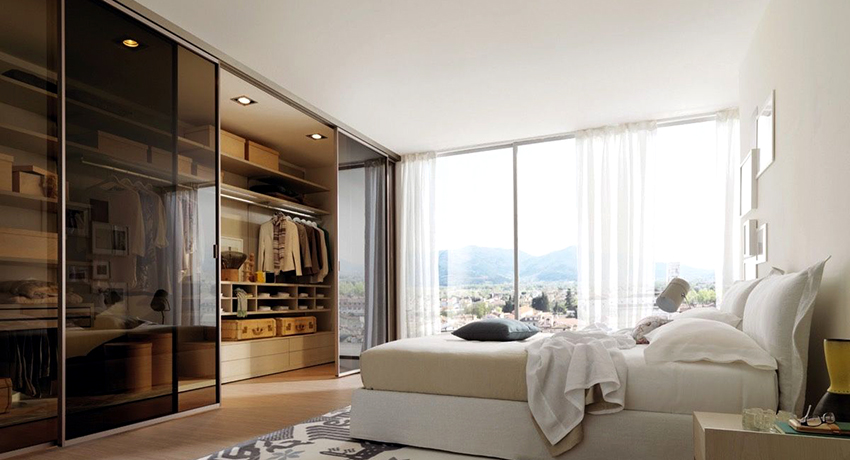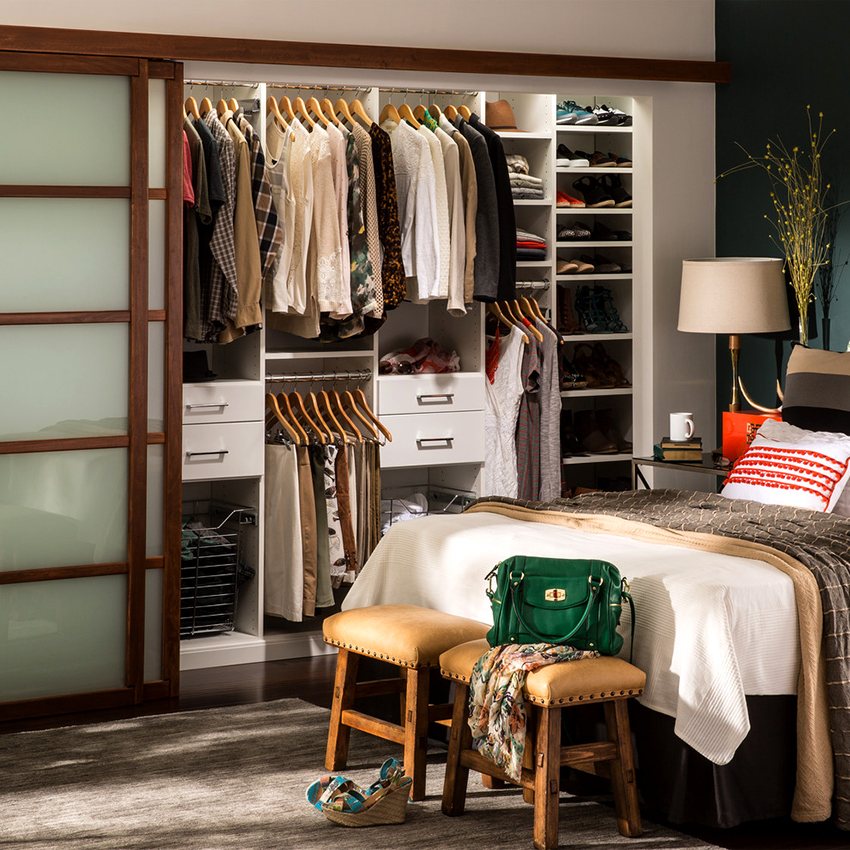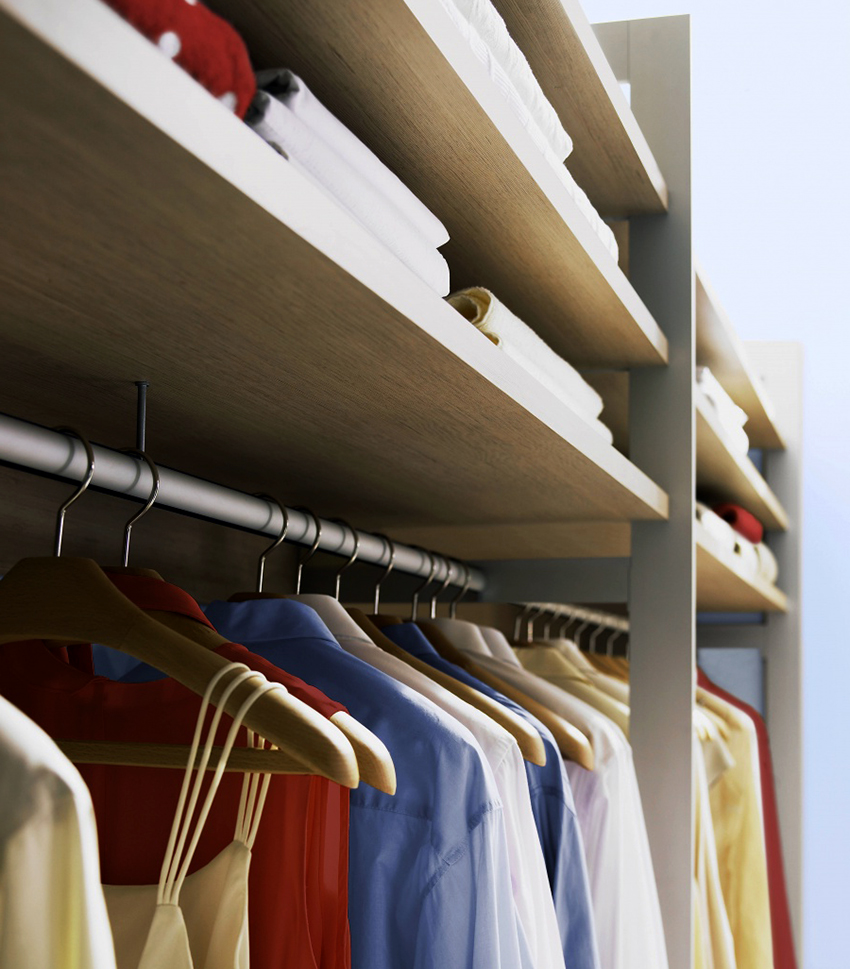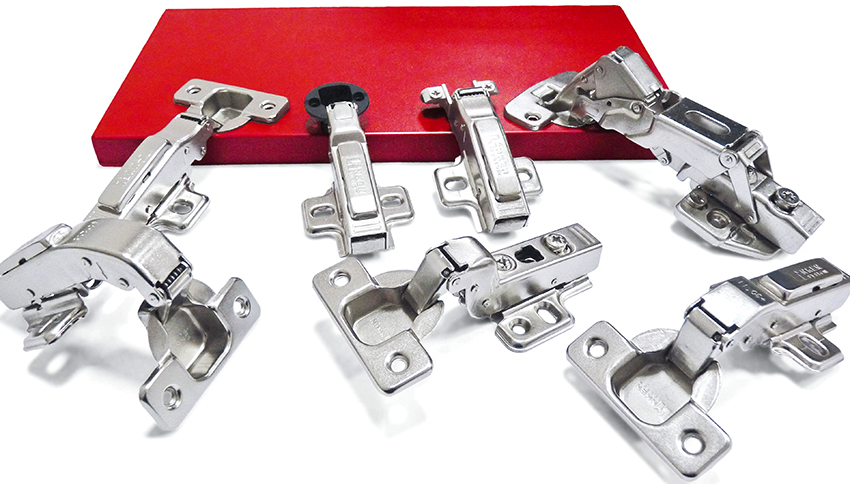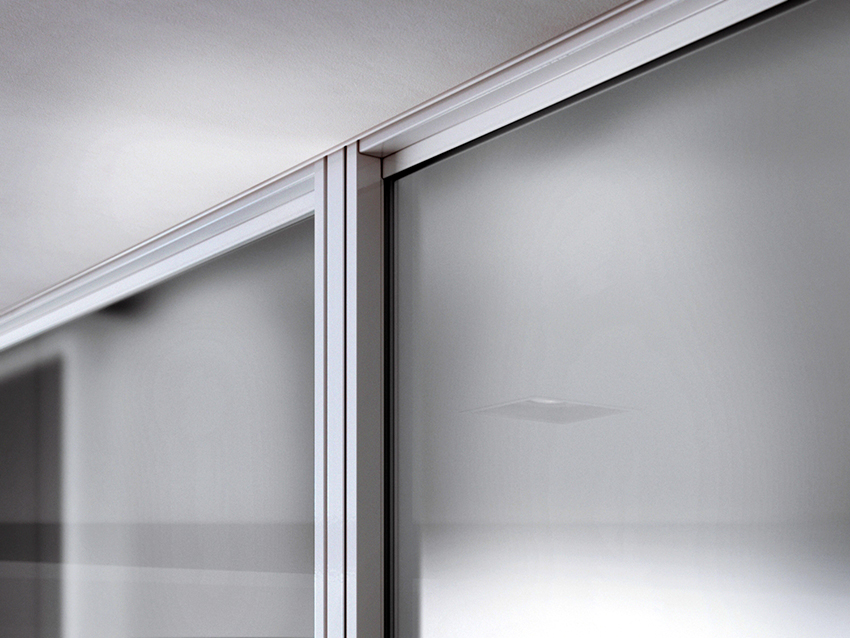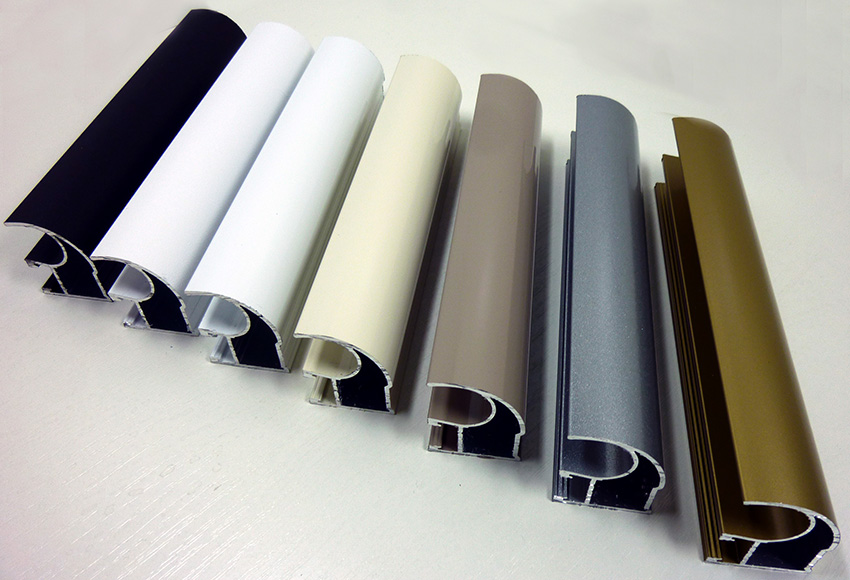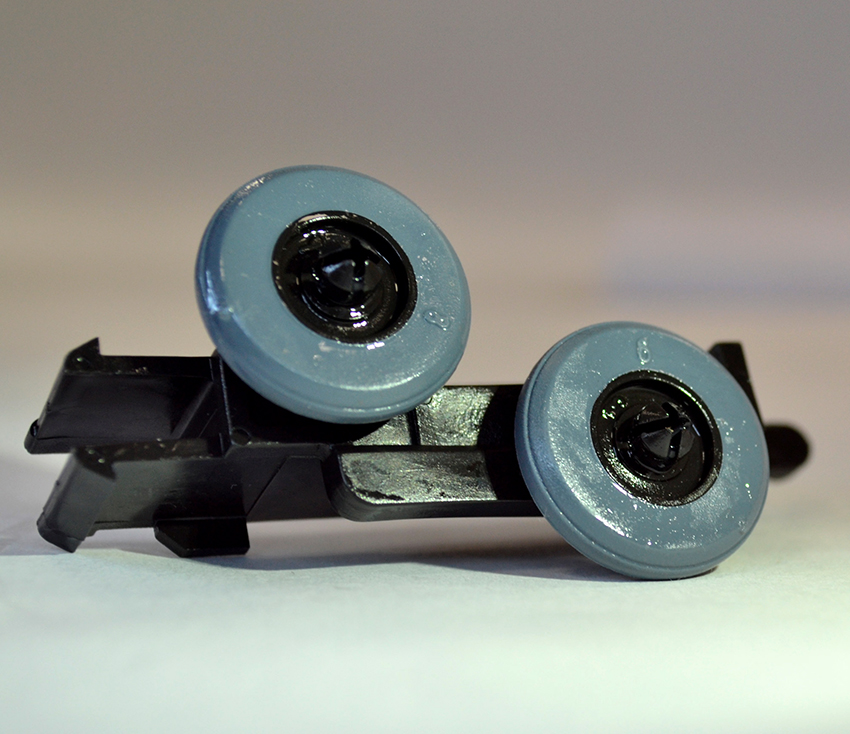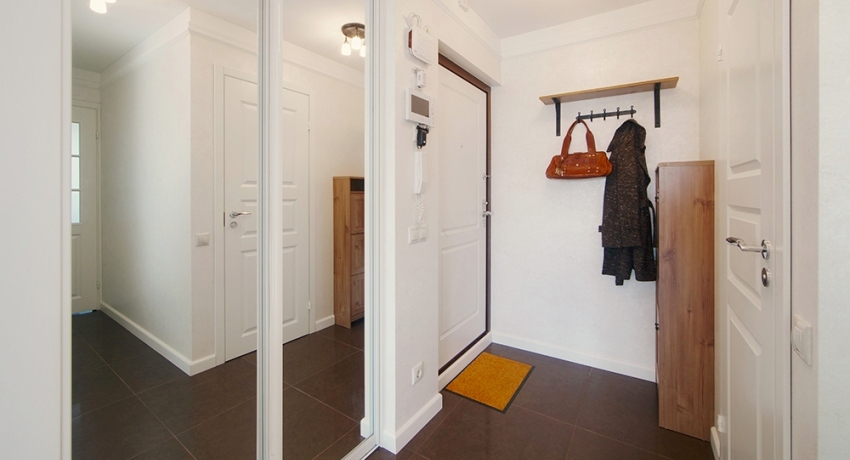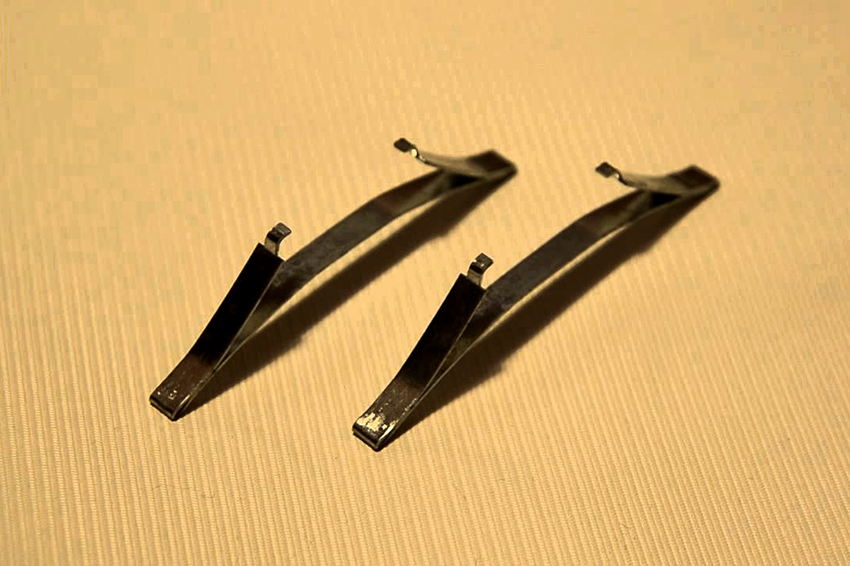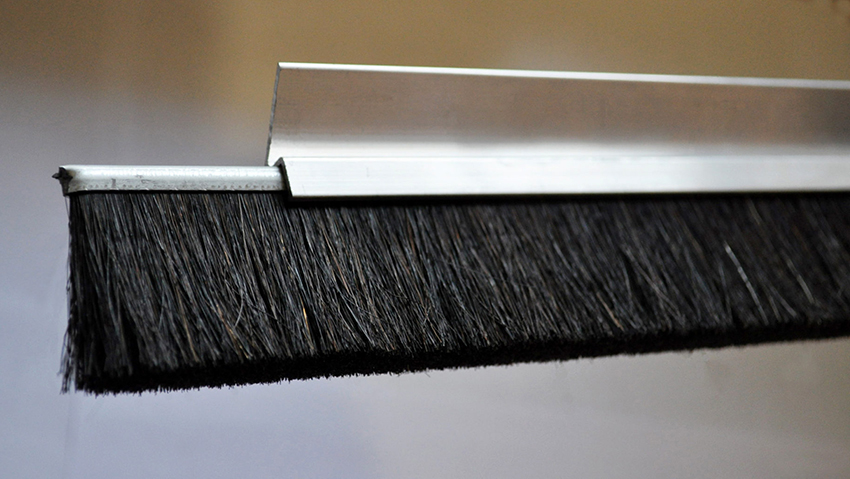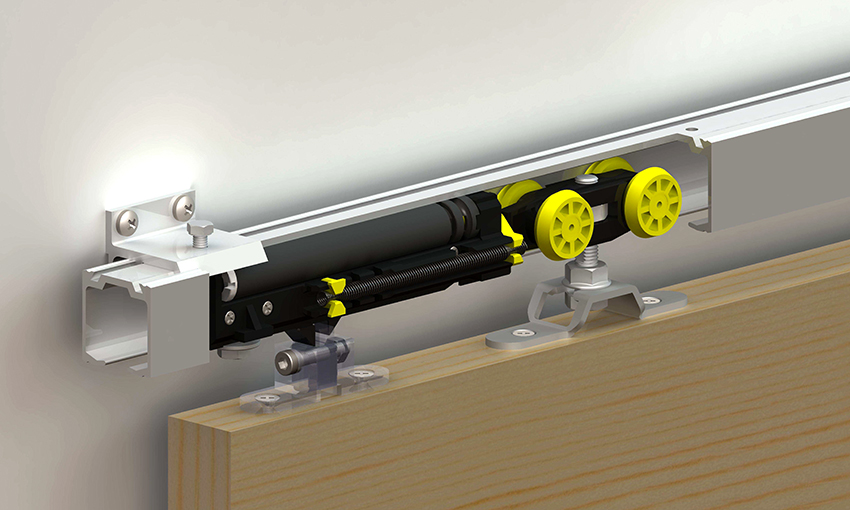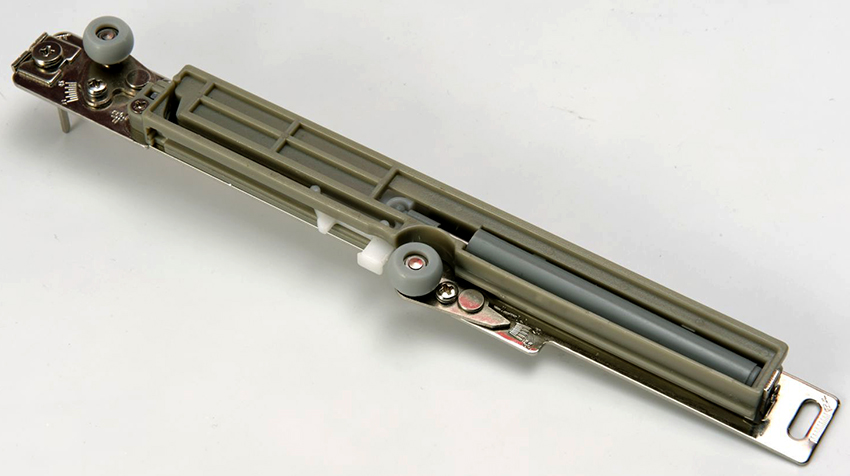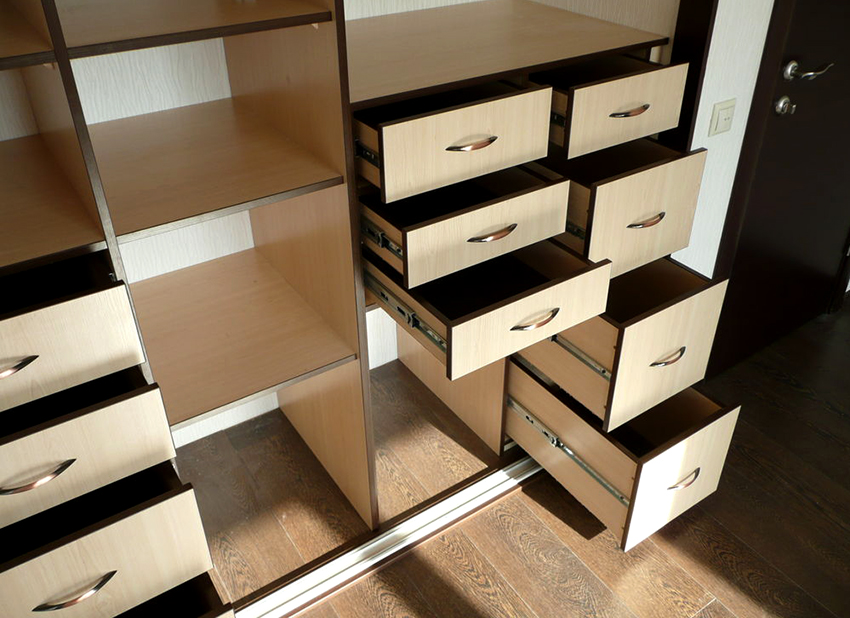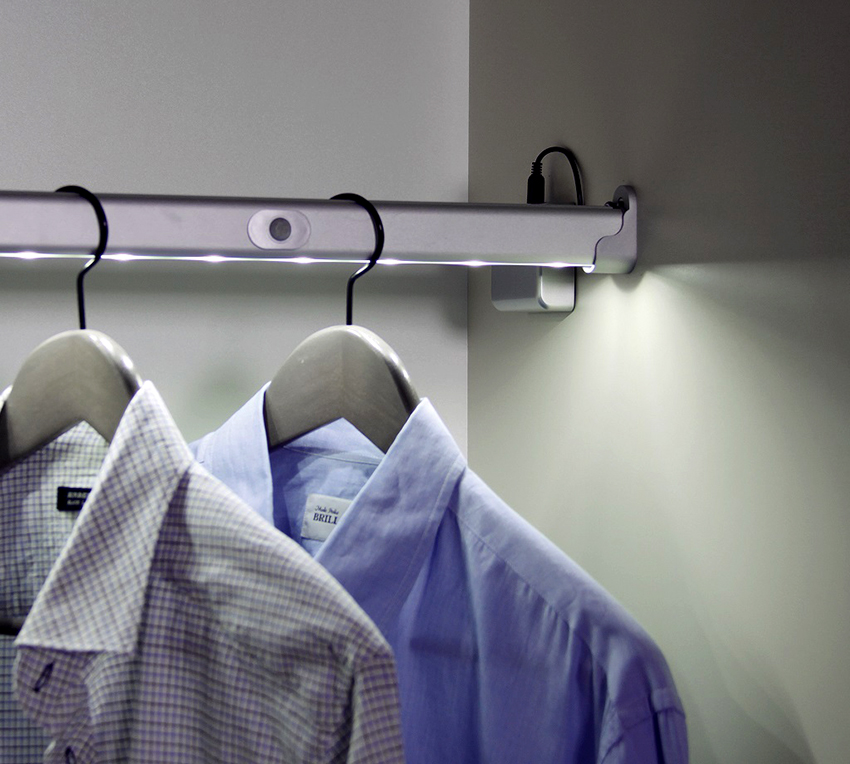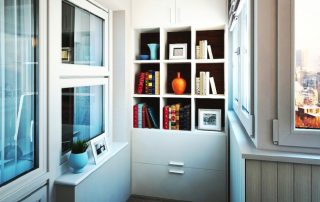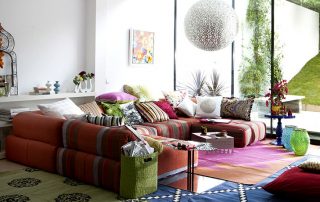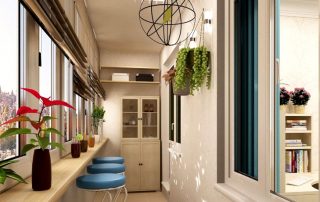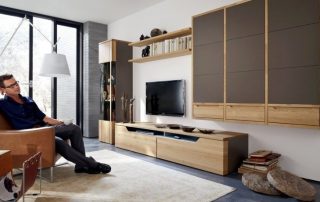Fittings for sliding wardrobes have significantly expanded the capabilities of this furniture. Storage systems have become more functional and comfortable. Sliding wardrobes are comfortable and practical, they are versatile and save space in the room. All this has become possible thanks to furniture fittings. From this article you can learn about all the features of this type of product, as well as learn more about their purpose.
Content [Hide]
- 1 Fittings for sliding wardrobes: classification and purpose
- 2 Decorative accessories in wardrobes: types of front fittings
- 3 The main types of fastening accessories for sliding wardrobes
- 3.1 Characteristics of profile fittings for sliding wardrobe doors
- 3.2 Door runner types: fittings for sliding wardrobes with ergonomic configuration
- 3.3 Features of adjusting rollers for wardrobes
- 3.4 Stoppers for wardrobe: characteristics and principle of operation
- 3.5 Varieties of sealing fittings for compartment doors
- 3.6 Functional fittings for sliding wardrobes: mechanisms for sliding wardrobes and door closers
- 4 Internal filling elements and pull-out accessories for sliding wardrobes
Fittings for sliding wardrobes: classification and purpose
Sliding wardrobes belong to the category of furniture with an ergonomic design. Most often, these structures are made to the full height of the room, thereby increasing the usable area. Inside you can place a large number of clothes, shoes, accessories and small household appliances. The sliding door system for wardrobes allows more efficient use of space in the room.
Durability, ease of use, as well as the functionality of the structures depend on what materials the manufacturer uses for wardrobes. The quality and reliability of the fittings are important. This concept implies a whole class of products, each of which has its own role.
Important! All components must correspond to the purpose of the cabinet, otherwise they will not be able to withstand the loads arising during operation.
Each type of fittings has its own characteristics and design features that allow it to perform certain functions. In sliding wardrobes, components are used for the following purposes:
- full functioning of drawers;
- sash fixation, which prevents spontaneous door closing;
- convenience when using all the elements of internal filling;
- installation of sliding wardrobe doors;
- accurate operation of cabinet walls and doors;
- assembly and fastening of all body elements;
- reliable and convenient door opening / closing process.
The existing types of fittings can be divided into two classes:
- Fasteners.
- Facial.
Front fittings mainly serve as a decorative function. It is used for decoration, although it is not devoid of certain possibilities. The functionality of fasteners is more expanded:
- connection of individual furniture components;
- opening / closing leaves;
- lifting, lowering and rotating furniture elements, etc.
All elements of furniture fittings and accessories for sliding wardrobes are supplied unassembled with the body part of the structure. Therefore, it is very important to know the purpose of each part, especially if the furniture assembly will be done by hand.
Decorative accessories in wardrobes: types of front fittings
This class of products includes elements that remain visible after cabinet assembly. The main types of front fittings:
- Handles for sliding wardrobes - used to open doors, drawers and doors. If drawers are provided in the wardrobe, it is advisable to use mortise handles, which are not only easy to use, but also will not create obstacles to opening the sliding system. This type of handle can also be used on door leaves. To fix such products, facade milling is used. The handles are oval, round and rectangular.
- Edging materials - have a decorative purpose, improve the appearance of furniture, and also protect the edges from mechanical damage.
- Locking mechanisms for sliding wardrobes - used to lock door leaves and built-in drawers.
- Decorative components are elements that are used as decorations, as well as products used to mask seams and various structural details. They look like overlays, which can be three-dimensional or flat.
Note! If desired, additional fittings can be added to the standard package during the assembly of the cabinet, if a place has been provided for it in advance.
There are several requirements for front fittings. Since these elements are located on the outside of the cabinet and are visible, they must maintain their aesthetics for a long time. In addition, the front fittings should be easy to use. It is advisable to select products with a durable coating that will not be subject to mechanical damage, abrasion and fading.
Manufacturers use wood, metal or plastic for the manufacture of decorative fittings. The type of material is selected taking into account the design of the furniture, as well as the structural features of the cabinet.
The main types of fastening accessories for sliding wardrobes
A standard set of fittings for built-in wardrobes looks a little different than equipping furniture with swing doors, and it includes the following components:
- guides;
- profiles;
- positioners (stoppers);
- sliding system;
- seals.
Each of the mentioned types of fittings has its own characteristics and purpose, therefore, they should be considered separately.
Characteristics of profile fittings for sliding wardrobe doors
The profiles are used for the installation of sliding wardrobe doors. These elements represent a metal frame. On the furniture fittings market, you can find two types of profiles: aluminum and steel.
Steel products are relatively cheap. They are most often used in domestically produced cabinets, as well as in economy class models.For their manufacture, sheet steel is used, the thickness of which varies between 0.3-0.8 mm. The thinner the sheet, the lower the cost. The color range of profiles is limited, so they are not as popular as aluminum ones.
Thin steel bends easily, which is a significant disadvantage of such products. In addition, they are heavy, which imposes certain restrictions on the dimensional parameters of the doors.
Aluminum fittings for sliding wardrobe doors are presented in two types of products, which differ from each other in the coating material - polyvinyl chloride or anodized. Such profiles are characterized by low weight, durability and a wide range. On sale you can find elements in various colors that imitate different types of textures. Therefore, the buyer will be able to choose the profile of the desired shade.
Helpful advice! If it is not possible to embed the handle, the vertical door profile can perform a similar function. This method is also resorted to in order to save money.
Due to the high strength and rigidity of aluminum components for compartment doors, as well as due to the presence of a durable coating, the cost of such products is much higher than the price of steel ones. Due to the low weight of the frame part, manufacturers can produce sash heights up to 3.2 m.
The anodized profiles have a hard surface, therefore they are more resistant to mechanical stress. These elements have a long service life, are not scratched and are not afraid of exposure to direct sunlight.
If the priority for the buyer is the silent movement of door leaves, it is better to install PVC-coated profiles in the cabinet.
Door runner types: fittings for sliding wardrobes with ergonomic configuration
The guides are the same profiles, but with grooves in the center. They are designed to be installed on the door of the wardrobe-compartment of rollers that ensure the movement of the doors. Each piece of furniture with a sliding system has two guides. One such product is mounted in the upper panel, the second in the strip located below, and between them there is the door itself. For the manufacture of guides, the following materials are used:
- aluminum;
- steel;
- plastic.
The best option for sliding-type wardrobes is considered to be aluminum products, which have excellent operational and decorative characteristics, ergonomics and a wide palette of colors. If we take into account the long service life of such guides, then we can close our eyes to their relatively high price.
There are several types of guides for wardrobe door mechanisms:
- single-lane;
- two-lane;
- three-lane.
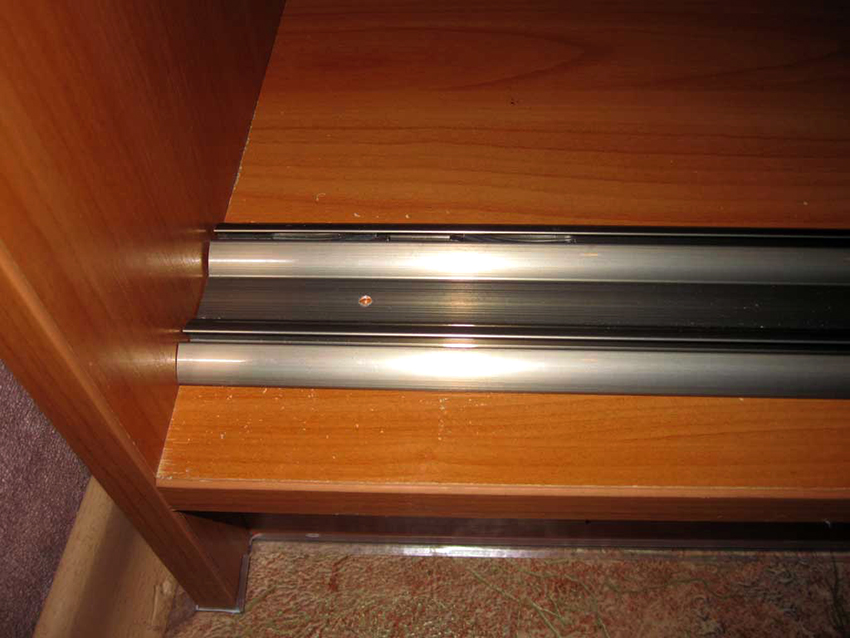
Slides for wardrobes made of plastic, steel or aluminum
The choice of guides depends on what type of mechanism is used in the sliding system, as well as on the number of door leaves.
Helpful advice! To install these fittings, it is imperative to use self-tapping screws intended for wood as fasteners.
Features of adjusting rollers for wardrobes
The door leaf moves along the body slats due to rollers. These elements of furniture fittings have a base on which wheels for sliding wardrobes are fixed. Comfort of operation depends on the quality of the rollers, since they provide a soft and smooth movement of the flaps. Most of these products are equipped with bearings that reduce the noise level when opening and closing doors.
As accessories for sliding wardrobes, door rollers are available in two versions:
- Symmetrical products are located on the same level with the door leaf, which makes it possible to drown the sash inside the cabinet during installation. This mounting method is used in furniture with facades made of glass, plastic or mirrors. This type of hardware is designed for doors with a closed handle.
- Asymmetric products - their function is to move the door leaf along the lower guide. The upper wheel supports the sash, and the lower one is used as a support.
- The owner of the cabinet can adjust the height of the asymmetric casters. Such products are usually installed in doors with an open handle.
The lower rollers are not only used to fasten the doors of the wardrobe, but also adjust the position of the sash in tilt and height. The capabilities of this hardware allow you to raise the canvas to a height of 20 mm in relation to the frame part. When choosing casters for a cabinet, you need to pay special attention to their quality. The number of wheels required for the sliding system to function depends on the weight of the door leaf. Symmetrical rollers eliminate the possibility of skewing during the installation of the blades.
Related article:
Sliding wardrobe in the hallway: photo of various design variations
Photos of models of various configurations. Organization of the filling system. Manufacturing material. Self-assembly of the cabinet.
Stoppers for wardrobe: characteristics and principle of operation
Stoppers (positioners) are always included in the standard set of fittings that are attached to compartment-type cabinets. These elements are fixed on both sides of the door profile. As they approach the walls, the stoppers slow down the movement of the sash, and also act as latches. The positioner is a metal bar equipped with springs (whiskers). One such element is allocated for each canvas. The number of stoppers depends on the number of doors in the cabinet design.
Helpful advice! It is advisable to buy high quality steel positioners for the cabinet. Before installation, it is imperative to check these accessories for integrity.
The principle of the stoppers is as follows:
- when the door leaf opens, the roller moves along the lower guide;
- the wheel runs over the lower metal plate of the positioner;
- when the roller falls into the gap between the plates, the door leaf is blocked.
It is erroneous to believe that there is no need to install such hardware for sliding cabinet doors. Of course, designs with two canvases can do without a stopper. If there are more flaps, mounting the positioner is a must. Otherwise, it will be inconvenient to use the sliding system. On sale you can find stoppers that are installed from above. Such products are part of hinged-type sliding systems. They look like a bar made of rubber. These stops fit into the ends of the rails.
Varieties of sealing fittings for compartment doors
To prevent dust from getting inside the cabinet, a damping tape is used, which is installed along the perimeter of the door leaf. This seal, called a schlegel, ensures that the sash fits snugly against the body. For the manufacture of sealing fittings, polyurethane and silicone are used. In addition, there are brush options - schlegels.
A damping tape made of polyurethane and silicone is usually supplied with aluminum profiles. Seals of this type drown out the noise generated by the movement of the door leaf. They are reliable and safe for human health, since environmentally friendly raw materials are used for the manufacture of these products.The brush strip has a two-layer structure. It consists of a fleece-coated adhesive backing. This seal effectively traps dust and also cushions impacts.
The fittings used to seal the doors in sliding wardrobes are of the following types:
- U-shaped (4 mm) - installed in furniture with facades made of mirrors, glass and plastic. The thickness of the seal is 4 mm. Allowed to be used together with an aluminum profile.
- Herringbone - has a completely different configuration than the previous version, although it can also be used as a seal for glass and mirror surfaces.
- U-shaped (8 mm) - designed for decorative inserts that decorate the facades. The thickness of this seal is 8 mm.
Helpful advice! If the floor in the room is uneven, it is better to give preference to furniture with adjustable legs.
As for the Schlegel in the form of a soft brush, this version of the seal is glued to a vertically located guide on the cabinet doors. For this, special grooves are provided on the fittings. Manufacturers make brushes with a pile thickness of 12 and 6 mm.
Functional fittings for sliding wardrobes: mechanisms for sliding wardrobes and door closers
Sliding systems are the main mechanisms for compartment doors that ensure the operation of the leaves. Cabinets of this type are in high demand among consumers, so manufacturers produce fittings that are supplied complete with furniture or separately from it. On sale you can find two options for sliding systems:
- Supporting - these mechanisms include profiles from which the stiffening frame is formed, rollers and guides (2 pcs.) Made of aluminum. Such designs have a simple assembly system, they are reliable and can be used in combination with large door leaves.
- Suspended - includes only one guide (top), stoppers and a roller carriage. These systems provide silent door opening, and the accessories for them are inexpensive. It should be noted that suspension systems can be used together with door leaves that do not have frames in the form of profiles.
When choosing the type of sliding system, it is imperative to take into account such factors as the size and weight of the door leaves, the type of mechanism installed in the cabinet, and the features of the facades. Suspended options are more convenient to use, but they need frequent adjustment. Support systems are durable.
If the width of the opening is not enough for the installation of a sliding system, manufacturers complete the wardrobe with a mechanism for sliding doors with a pivot structure. This element is called a pivot and is installed in furniture structures that have a corner section.
Closers are mechanisms that are included in the package of sliding systems. They ensure smooth closing of door leaves. It is enough to push the sash in the desired direction, and the closer will cope with the rest. Thanks to these mechanisms, the doors are closed without unnecessary noise and knocking.
Interesting fact! Versailles is the most widespread and popular sliding system.
Internal filling elements and pull-out accessories for sliding wardrobes
Manufacturers pay special attention to the distribution of internal space in the cabinet. The more successful the filling is, the more spacious and comfortable the furniture is. The sets of accessories for the wardrobe can be very diverse. When choosing filling for furniture, you need to decide in advance what things will be stored inside and how they will be located there.
Common types of retractable furniture fittings for sliding wardrobes
Many elements of the internal filling function using retractable fittings. These products are predominantly metal or plastic guides.
There are several types of retractable fittings:
- Roller is the most common component option. Such fittings are capable of withstanding weight loads up to 25 kg. Often these products are supplied complete with a door closer.
- Ball - elements of internal filling that move thanks to balls. This type of fittings has a wide range of sizes, and also provides easy opening of drawers.
- Tandems are a type of product installed inside the box. The system allows you to use the maximum space in the cabinet. In this case, the gap width does not exceed 4 mm. Tandems work silently; you can find a huge number of components for them on sale.
- Metaboxes are systems that are made of plastic or metal (steel). They consist of drawer sides and rails equipped with rollers. Metaboxes allow you to slide out a drawer partially or completely. These products are manufactured in different sizes.
Important! Before installing the sliding elements, you need to make sure that they will not be blocked by the sliding system in the open state. All mechanisms present in the cabinet should not interfere with each other during operation.
Additional accessories for sliding wardrobes: elements of internal filling
The elements of the internal filling are of a fixed size, which must be taken into account at the planning stage of the cabinet and when purchasing accessories. They allow you to neatly place shoes and clothes, as well as other items.
Common interior fittings include:
- The rod is a metal pipe that is installed horizontally inside the cabinet between its walls. It is designed for clothes hangers.
- Hangers - outwardly resemble a bar and they are mounted across the cabinet. Such designs are being pushed forward, although there are stationary options.
- Trouser - there are several configurations of similar products. The most successful option is considered to be with pins. When installed, this element is fixed on the back of the cabinet or on its sides.
- Pull-out storage systems - these are drawers or mesh baskets.
In addition, the closet may contain holders with hooks for belts, shoe shelves, tie clips, pantographs. If necessary, this set can be supplemented with special holders made of wire for an iron and a hose from a vacuum cleaner. Also, furniture legs and shelf supports made of metal and plastic can be classified in this category of products.
Furniture manufacturers offer a huge selection of fittings and components for sliding wardrobes, so each buyer can independently organize the interior space and use it to the maximum. Of course, it is not necessary to install all of the listed items, but some of them can be very useful. You just need to be guided by your own needs.
